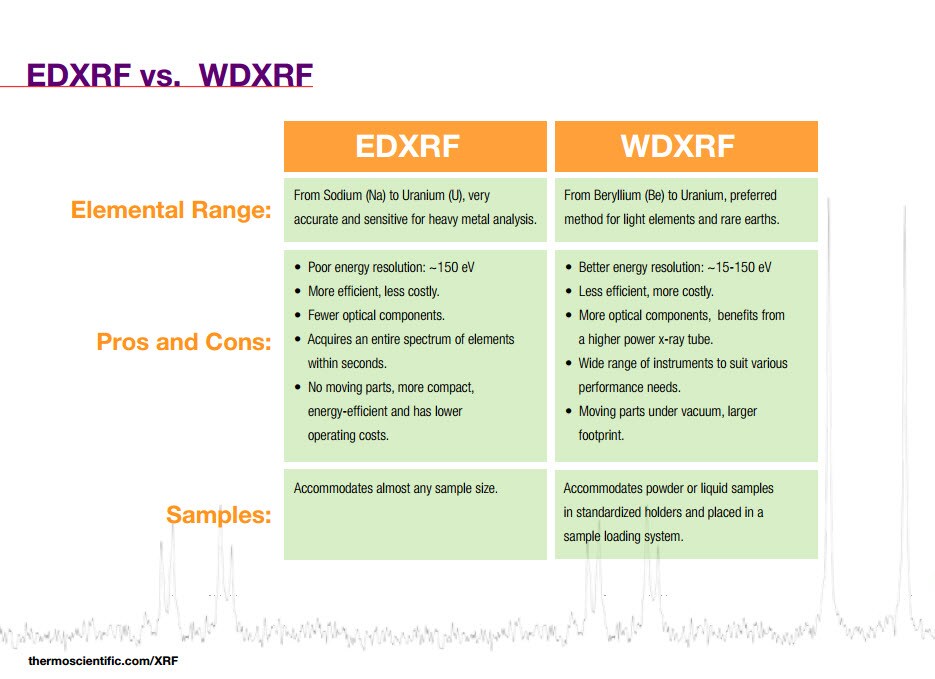 Many articles in this blog discuss X-ray fluorescence (XRF) technology, a non-destructive analytical technique used to determine the chemical composition of materials. XRF is an excellent method for qualitative and quantitative analysis of material composition because it is able to identify the unique “fingerprint” of each element. This technique has numerous applications in industries including metals, mining, and plastics, many of which can be performed by either, or both, handheld and lab-based instrumentation.
Many articles in this blog discuss X-ray fluorescence (XRF) technology, a non-destructive analytical technique used to determine the chemical composition of materials. XRF is an excellent method for qualitative and quantitative analysis of material composition because it is able to identify the unique “fingerprint” of each element. This technique has numerous applications in industries including metals, mining, and plastics, many of which can be performed by either, or both, handheld and lab-based instrumentation.
Handheld XRF analyzers are designed to provide instant elemental analysis in situations where immediate feedback is needed to determine the next course of action. Lab-based XRF analysis can be used in tandem with handheld XRF analysis to provide confirmatory data, but its analytical range and applications are wider. Laboratory-based XRF systems provide qualitative and quantitative analysis for process and quality control. Lab-based XRF can evaluate all kinds of materials and sample types including conductive or non-conductive solids, liquids, loose powders, pressed pellets, fusion beads, pastes, granules and coatings.
The two primary types of lab-based XRF systems are Energy Dispersive X-ray Fluorescence (EDXRF) and Wavelength Dispersive X-ray Fluorescence (WDXRF). Each has a different detection system. EDXRF instruments may be either handheld for use in the field, or benchtop for use in a lab. EDXRF is a convenient technology to screen all kinds of materials for quick identification and quantification of elements with little or no sample preparation. Low cost of ownership and rapid elemental analysis of regular or irregular samples make EDXRF an attractive front-end analysis tool.
WDXRF is the standard test method for analytical laboratories serving applications as diverse as cement manufacturing, metallurgy, mining, geology and geochemistry, petroleum, polymers, glass and ceramics, semiconductors, paints and chemicals, forensics investigations, and environmental applications. WDXRF technology is well established for high sensitivity down to low atomic number elements, high repeatability and element selectivity in order to achieve the performance needed for routine industrial applications. WDXRF is also exploited for its wide dynamic range and extremely good reliability for laboratory applications.
Here’s a chart to give you a quick glance of the differences of each technology when it comes to elemental range, samples, and benefits.
Want to learn more about portable XRF or lab-based XRF? Download our free eBooks: Portable XRF Technology and XRF in the Lab for the Non-Scientist.







This site was… how do I say it? Relevant!! Finally I’ve found something which
helped me. Cheers!
This post is worth everyone’s attention. Where can I find out more?
You can learn more about XRF here: http://www.thermofisher.com/us/en/home/industrial/spectroscopy-elemental-isotope-analysis/oes-xrd-xrf-analysis/x-ray-fluorescence-xrf.html
Can portable XRF be used in a laboratory and give accurate results and be used for process control (changing plant settings in order to achieve target grade). Will the results be good enough if fused beads are used
Hi Barry–
Thank you for your question. I checked with Mark Lessard, our inhouse expert, and here is his answer: “The dilution process associated with the sample preparation technique of creating a fused bead would most likely put the elements of interest below the limit of qualification for portable Energy Dispersive XRF. Though we would be happy to confirm that by performing an application study on your fused bead standards/samples. If you interested, please let us know.”
Sorry you are having this problem. It looks OK on our side.